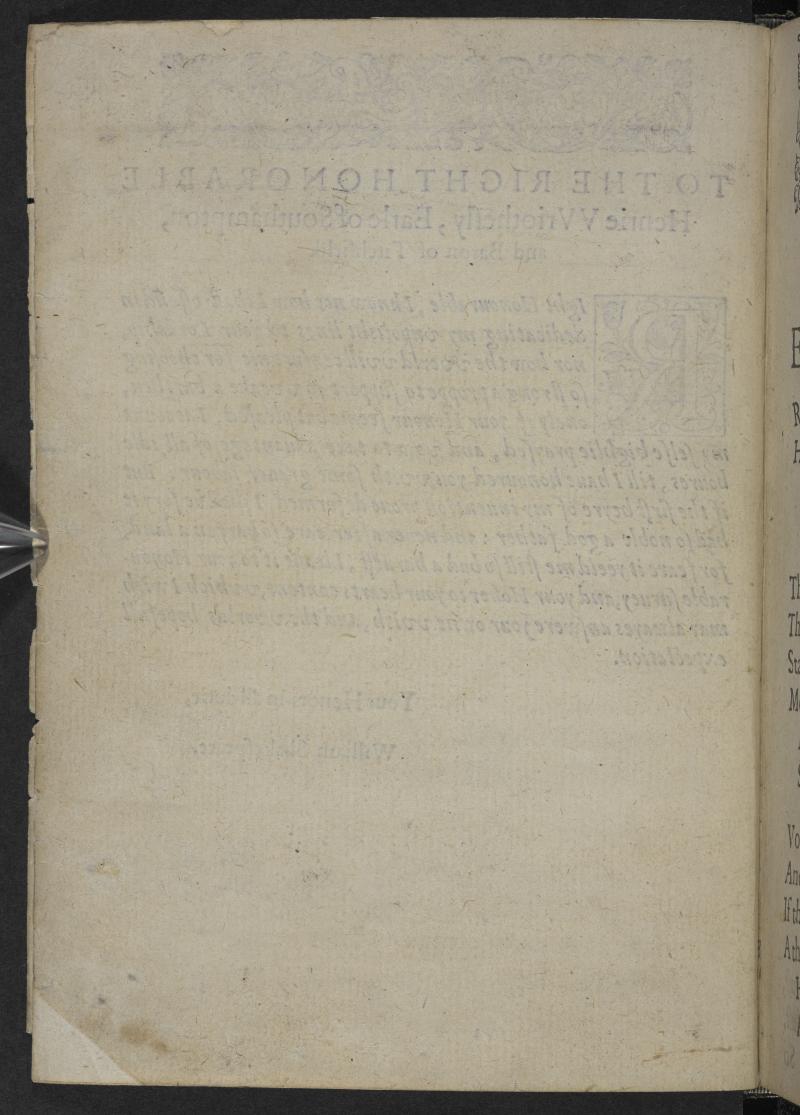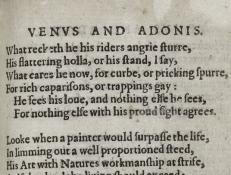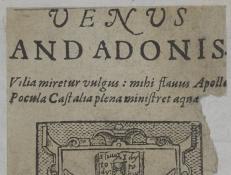From the collections of: THE BRITISH LIBRARY
Terms of use
The British Library has graciously contributed the above images to Shakespeare Documented under a Creative Commons Public Domain Mark.
Copy-specific information
Creator: William Shakespeare
Title: Venus and Adonis. Vilia miretur vulgus: mihi flauus Apollo. Pocula Castalia plena ministret aqua.
Date: London : Imprinted by Richard Field, and are to be sold [by John Harrison] at the signe of the white Greyhound in Paules Church-yard, 1594.
Repository: The British Library, London, UK
Call number and opening: G.11180, title page & sigs. A2r-A2v
View online bibliographic record
Erin A. McCarthy, "Venus and Adonis, second edition," Shakespeare Documented, https://doi.org/10.37078/566.
British Library, G.11180. See Shakespeare Documented, https://doi.org/10.37078/566.
The second edition of Venus and Adonis was published in 1594, only one year after the first edition. The speed with which it was republished suggests that the poem was popular enough to have already sold out or nearly sold out. In fact, the poem would go through fourteen more editions before 1640. Perhaps because Shakespeare's Venus pursues Adonis and her own pleasure rather boldly, Venus and Adonis seems to have appealed to contemporary women readers in addition to the witty and urbane young men who usually consumed Ovidian verse. In Thomas Middleton's 1608 comedy A Mad World, My Masters, for instance, a husband reports that he has "conveyed away all [his wife's] wanton pamphlets," (Pearson 88) including Venus and Adonis. Like the first edition of Venus and Adonis, the second edition was published by Richard Field, also from Stratford-upon-Avon.
Although Shakespeare is now known primarily as a playwright, in his own time he was equally revered as the author of Venus and Adonis, first printed in 1593, and Lucrece, his two sensationally successful Ovidian narrative poems. Venus and Adonis appeared in more printed editions than any other work of vernacular poetry in his lifetime, and was published twice as many times as his most successful play, Henry IV Part 1.
The first known owner of the copy shown here was the nineteenth-century book collector Thomas Jolley, an orange merchant and book collector. Bibliographer Thomas Dibdin describes Jolley's purchase vividly, noting that Jolley
stumbled, in one of his Lancashire rambles, upon an unostentatious little volume, containing....what! think'st thou, gentle and curious reader?...containing...the Venus and Adonis of 1593 and the Sonnets of 1609 ..both FIRST EDITIONS—in one and the same volume. (808)
The volume was, in fact, a copy of the 1594 edition. Shown here, it is one of six known to survive. When Jolley's collection was sold at auction, it was purchased by Thomas Grenville, who in turn bequeathed it to the British Museum. This copy became part of the British Library's collections under the 1972 British Library Act.
To learn more about the plot and early printing history of Venus and Adonis, please visit the Folger's Shakespeare's Works; to read a modernized edition of the poem, see the Folger Shakespeare edition.
Written by Erin A. McCarthy
Sources
Thomas Frognall Dibdin, The Library Companion: or, the Young Man's Guide, and the Old Man's Comfort, in the Choice of a Library (London: for Harding, Triphook, and Lepard, and J. Major, 1824).
Sidney Lee, ed., Shakespeares Venus and Adonis: Being a Reproduction in Facsimilie of the First Edition (Oxford: Clarendon Press, 1905).
Jacqueline Pearson, “Women reading, reading women,” in Women and Literature in Britain, 1500–1700, ed. Helen Wilcox (Cambridge: Cambridge University Press, 1996), 80–99.
Sasha Roberts, Reading Shakespeare's Poems in Early Modern England (New York: Palgrave, 2003).
Philip John Weimerskirch, Antonio Panizzi and the British Museum Library, in The AB Bookman's Yearbook, 1981 (Clifton, NJ: Bookman's Weekly, 1982).
Last updated June 10, 2020
















![Capell *.22[2], signatures A2 verso and A3 recto, thumbnail detail](https://shaxdoc.titania.folger.edu/sites/default/files/styles/document_thumbnail/public/document-thumbnails/Capell.star_.22_dedication%202_thumbnail%20detail.jpg?itok=SUhQBmMZ)








